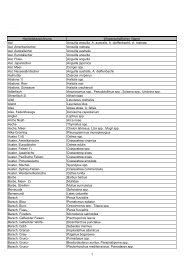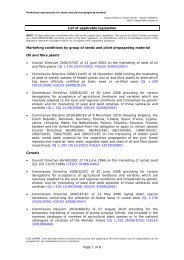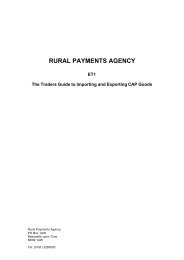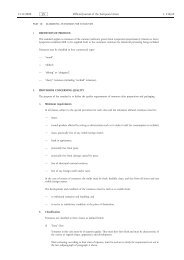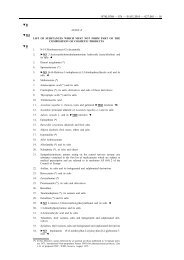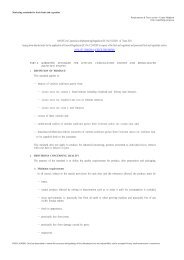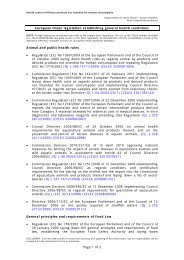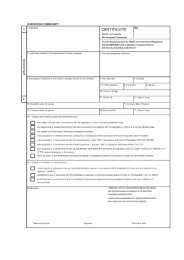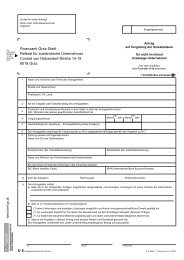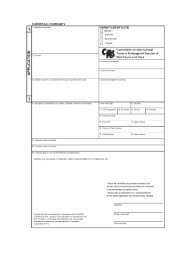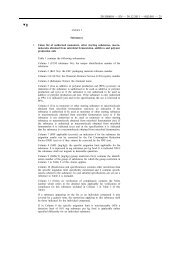best practice guidance on the labelling and packaging of medicines
best practice guidance on the labelling and packaging of medicines
best practice guidance on the labelling and packaging of medicines
You also want an ePaper? Increase the reach of your titles
YUMPU automatically turns print PDFs into web optimized ePapers that Google loves.
<strong>labelling</strong>, will form part <strong>of</strong> <strong>the</strong> critical <strong>labelling</strong>. Many <strong>medicines</strong> will notneed <strong>the</strong> additi<strong>on</strong> <strong>of</strong> any warnings <strong>on</strong> <strong>the</strong> fr<strong>on</strong>t <strong>of</strong> <strong>the</strong> pack. This secti<strong>on</strong> isintended to c<strong>on</strong>vey <strong>on</strong>ly those critical warnings necessary immediately prior toadministering <strong>the</strong> product. Examples <strong>of</strong> warnings that are c<strong>on</strong>sideredappropriate for <strong>the</strong> critical field include:Fatal if given by o<strong>the</strong>r routesVinca alkaloidsCheck dose <strong>and</strong> frequency - methotrexate is usually taken Oral methotrexate<strong>on</strong>ce a weekDilute before useC<strong>on</strong>centratedpotassium chlorideC<strong>on</strong>tains paracetamolParacetamolc<strong>on</strong>taining<strong>medicines</strong>4.3. The critical informati<strong>on</strong> should appear in as large a f<strong>on</strong>t as possible tomaximise legibility, <strong>on</strong> at least <strong>on</strong>e face <strong>of</strong> <strong>the</strong> presentati<strong>on</strong>. It should notbe broken up or separated by n<strong>on</strong>-critical informati<strong>on</strong>. The criticalinformati<strong>on</strong> (see 4.1 above) should appear in <strong>the</strong> order stated. Although use <strong>of</strong>a large f<strong>on</strong>t may be appropriate, o<strong>the</strong>r factors may also be important in making<strong>the</strong> informati<strong>on</strong> legible. C<strong>on</strong>siderati<strong>on</strong> should be given to <strong>the</strong> line-spacing <strong>and</strong>use <strong>of</strong> white space to enhance <strong>the</strong> legibility <strong>of</strong> <strong>the</strong> informati<strong>on</strong> provided. Forsome small packs it may not be possible to present all <strong>the</strong> critical informati<strong>on</strong><strong>on</strong> <strong>on</strong>e face.4.4. Innovative pack design that may incorporate <strong>the</strong> judicious use <strong>of</strong> colour isto be encouraged to ensure accurate identificati<strong>on</strong> <strong>of</strong> <strong>the</strong> medicine. Inc<strong>on</strong>sidering <strong>the</strong> acceptability <strong>of</strong> a particular pack design it will be necessary toc<strong>on</strong>sider <strong>the</strong> relative distinguishing features compared to o<strong>the</strong>r packs in arange (a range may mean all packs bearing a corporate livery or a group <strong>of</strong>packs carrying <strong>the</strong> same design <strong>the</strong>me). The primary aim <strong>of</strong> innovativedesign <strong>of</strong> <strong>packaging</strong> is to aid in <strong>the</strong> identificati<strong>on</strong> <strong>and</strong> selecti<strong>on</strong> <strong>of</strong> <strong>the</strong>medicine.4.5. Where practicable, packs should include space for <strong>the</strong> placement <strong>of</strong> <strong>the</strong>dispensing label. It is recommended that this should be a blank whitespace in which <strong>the</strong>re is no text <strong>of</strong> any kind, to aid legibility <strong>of</strong> <strong>the</strong>dispensing label. Where it is not possible to employ a blank space, use <strong>of</strong> acolour that will not interfere with <strong>the</strong> readability <strong>of</strong> <strong>the</strong> dispensing label shouldbe c<strong>on</strong>sidered. This c<strong>on</strong>siderati<strong>on</strong> need not apply to products intended forover-<strong>the</strong>-counter sale directly to <strong>the</strong> patient.4.6. Only positive statements should appear <strong>on</strong> <strong>medicines</strong> <strong>labelling</strong> to avoidambiguity <strong>of</strong> <strong>the</strong> message. For example, “For intravenous use <strong>on</strong>ly”.Negative statements such as “Not for intravenous use” should not be used.4.7. Undertaking a user test to ensure <strong>the</strong> maximum clarity <strong>of</strong> <strong>the</strong> criticalinformati<strong>on</strong> is desirable <strong>and</strong> recognised as <str<strong>on</strong>g>best</str<strong>on</strong>g> <str<strong>on</strong>g>practice</str<strong>on</strong>g>. Care should betaken to ensure that <strong>the</strong> test undertaken is applicable to <strong>the</strong> “user” because



